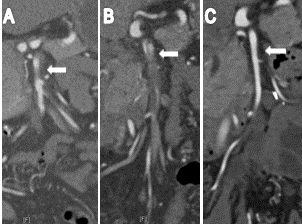10-year Review of Isolated Spontaneous Mesenteric Arterial Dissections 10-Year Review of Isolated Spontaneous Mesenteric Arterial Dissections
Courtney E. Morgan, MD, Mark K. Eskandari, MD, Heron E. Rodriguez, MD.
Northwestern University, Chicago, IL, USA.
OBJECTIVES: Isolated spontaneous dissection of the superior mesenteric artery (SMA) and celiac artery (CA) remains a rare condition, however has been increasingly noted incidentally on diagnostic imaging. We sought to study the natural history and outcomes of patients presenting with isolated spontaneous mesenteric artery dissections (SMAD) hypothesizing that most SMAD can be treated non-operatively.
METHODS: Single center retrospective review of patients presenting with the diagnosis of SMAD between 2006-2016. Data analysis includes demographics, clinical data, radiologic review, treatment and outcomes.
RESULTS: A total of 78 patients were found to have isolated CA or SMA dissection diagnosed on CT or MRI. Average age was 56 years (range 26 - 86), 80% were male, and 9 patients (12%) had underlying arterial pathology: 5 had fibromuscular dysplasia, and 4 had segmental arterial mediolysis. The majority, 64%, presented with symptoms including abdominal pain, back pain, chest pain, while the remaining 36% were asymptomatic. Combined SMA and CA dissection was found in 14 (18%) patients, while 33 (42%) presented with isolated CA dissection and 31 (40%) presented with isolated SMA dissection. Only 4 patients required intervention. Mesenteric bypass was performed in 2 patients, and SMA endarterectomy with patch angioplasty was performed in one patient for signs of bowel ischemia. No patient required bowel resection. The 2 bypasses were anastomosed to a branch of the SMA and complete lumen restoration was seen on long-term imaging follow up. (Figure 1) One patient underwent stent-grafting of the celiac and hepatic artery for aneurysmal degeneration 1 month after diagnosis. The remaining 74 patients were managed non-operatively: 40 (55%) were treated with a short course of anticoagulation 23 (31%) were treated with antiplatelet therapy, and 10 (14%) were treated with observation alone. No other later interventions or recurrence were noted over a mean follow-up period of 21 months.
CONCLUSIONS: While isolated SMAD poses a risk of visceral ischemia, the vast majority of patients presenting with this diagnosis can be treated non-operatively with a short course of antiplatelet or anticoagulant therapy. Indications for surgical intervention include bowel ischemia as well as aneurysmal degeneration. 
Back to 2017 Program




